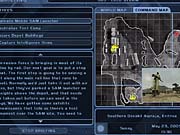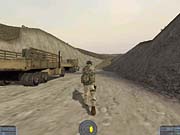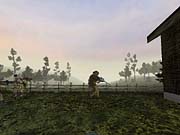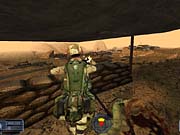Ghost Recon: Desert Siege Preview
We take a look at the forthcoming expansion pack to Ghost Recon.
Ahh, those pesky Russkies. You probably thought you'd calmed things down pretty well at the end of Ghost Recon, but it turns out that the way the bad guys in the motherland had financed their coup was by selling surplus arms to a rogue colonel in Ethiopia named Tesfaye Wolde--and he wasn't using them as decor for his sitting room, either. After toppling the legitimate Ethiopian government in 2008, Wolde has fixed his eyes on Eritrea, a small nation straddling the northern Ethiopian border that gained its independence from that country in 1993 after six decades of war. The Eritrean government is anxious to halt Wolde's invasion, but at the same time it realizes a large ground force could inadvertently destroy the poverty-stricken nation's infrastructure in the process. What it needs are fast, pinpoint tactical strikes aimed to slow Wolde's advance, which is another way of saying it's time for the Ghost Recon crew to get busy once again.

Unlike Red Storm Entertainment's mission packs for Rainbow Six and Rogue Spear, which featured only five new levels each (Covert Operations for Rainbow Six boasted nine, but it was a higher-priced stand-alone title), the Desert Siege mission pack features a respectable eight-mission single-player campaign that starts on the beaches outside the Eritrean coastal city of Massawa. That amphibious landing turns into a real nightmare when you run into multiple machine-gun emplacements, and the going gets even tougher on the next mission as you race against the clock to prevent Wolde's troops from dynamiting a refinery they've decided to destroy as part of a desperate scorched-earth policy (oh yeah, they're holding hostages in another building a few hundred meters from the facility!). Save the refinery and hostages, and you still must seize a rail depot quickly enough to ensure the rebels don't destroy valuable supply-line documents.

Those missions might faze newcomers, but in fact they serve as a baptism by fire, and the next few missions place more emphasis on fast-paced fun than hair-pulling challenge. Escorting a convoy of trucks carrying supplies to a refugee camp will give you a warm, fuzzy feeling even as you mow down enemies who've lined the roads to commandeer the vehicles, and eliminating the remains of a downed chopper is surprisingly easy because the Ghost Recon team is equipped with night-vision goggles. Retrieving a map detailing land-mine placement requires good coordination between two or three squads because the tangos are hiding behind wrecked vehicles interspersed between the hovels of a shantytown, but once you've sussed out the enemy strongholds all you need is patience to bring home the bacon.
But Wolde's saved his best troops for the last two missions. The first, Subtle Keep, pits you against two separate contingents of enemies--one ensconced in and around a castlelike structure and another entrenched along a road and hiding in bunkers overlooking a valley--that adapt to your tactics in surprisingly quick fashion. The final mission is a fast-paced firefight that's one of the most heart-pounding outings of the bunch--definitely a great way to end this minicampaign.
Tom and Jane
Because Ghost Recon shipped with the IGOR mission editor, these obviously aren't the first new assignments for the Ghost Recon team, but those missions could take place only in the environments of the Ghost Recon single- and multiplayer levels, not the sandy terrain of Desert Siege.

That may seem a small point, but in truth the Ghost Recon engine has probably never looked better than it does rendering the sun-scorched earth of Eritrea. Watching your troops scuttle over the cracked desert soil is utterly convincing, as are the glaring lens flares created whenever you glance up at the boiling sun (we're talking daytime missions--the desert doesn't have the same allure through the green glow of night-vision goggles). Should you tire of the desert setting, most of the five new multiplayer maps are set in temperate locales like Washington, Colorado, and North Carolina and understandably feature more trees and plant life. Mip mapping has been introduced in the new executable (version 1.2) that comes with the game to reduce flickering of distant texture; the patch also corrects some minor problems associated with full-scene antialiasing.
Since Rainbow Six, users have come to expect an impressive array of weapons from the Red Storm team, and Desert Siege doesn't disappoint. Red Storm has turned to the bible of small arms--Jane's Infantry Weapons (1999-2000 edition)--for its additions to the Ghost Recon arsenal, and it takes immense pride in modeling these babies as accurately as possible. Desert Siege adds nine new firearms to the Ghost Recon lineup: four assault rifles and variants (the Russian-made Groza, AN-94, and A-91 and the popular Belgian FN-FAL Para Variant), two machine guns (the born-in-the-USA M60 and the Russian PKM), two sniper rifles (the H&K PSG-1 introduced in Rogue Spear and the awesome Barrett M98), and a submachine gun (the Russian Bizon).

It's hard to argue with that lineup, and the selections are perfectly in keeping with the game's emphasis on open-terrain combat. The only gripes are, as in all Red Storm shooters, that you get merely a reticle instead of actually seeing the barrel of the weapon you're wielding and that the only weapon you can access in single-player mode is the PKM. Luckily, you can get familiar with the characteristics of all the new hardware by creating a multiplayer team game with AI friendlies and enemies and then selecting the kit of your choice.
Desert Siege also introduces five new specialists--two support personnel along with a rifleman, a demolitions expert, and a sniper--and they are the real stars of Desert Siege. You'll definitely appreciate their abilities on more difficult sorties because they all arrive with hefty stats, and once you've successfully completed a few missions you'll be able to max them out in the category of your choice. You can still expect to baby-sit them should they run into a hornet's nest of enemies, but for the most part the specialists do a good job on their own, giving you more time to focus on the squad you're currently controlling.
Additions and Changes
Because of Desert Siege's setting, all the enemies are new and, if you can get close enough to listen to their conversations, speak in Amharic. Anyone who's followed the fighting in Afghanistan will have noticed the prevalence of jeeps and trucks for swiftly moving troops over rugged terrain, and both are debuted in Desert Siege. You'll come across these mobile forces in several of the missions, and you'd best be on your toes when it happens: These guys must be used to popping off rounds while riding along dirt roads, because their accuracy is downright amazing.

Besides all the new stuff, the 1.2 patch introduces several small tweaks suggested by Ghost Recon users. Binoculars, for example, now behave the same as the sniper rifle: Pressing and holding the zoom key takes you to 5x magnification, with two presses taking you to 10x. The AN/GSQ-187 Sensor's range has been changed to 40 meters, and the options screen now lets you choose a default rate of fire for multiplayer and toggle an auto-run option. Most importantly, a quick-load feature now gives you the option of loading any previously saved game without being forced to return to the main menu and start from scratch.
Another area that's seen major and minor changes is the multiplayer game. Enhancing the multiplayer stat display so the leaderboard is more easily accessed and readable is a welcome but expected change; the inclusion of two new gameplay modes is a bigger and more appreciated addition. In domination mode, points are awarded for every second a predefined area is "owned" by a team, with ownership being defined as whenever a player enters the area when no enemy is present. Zones are obviously visible on the command map and can be identified in-game by columns of colored smoke. The siege mode pits one team defending a base against a team trying to seize it--if the assaulting team claims the ground for five seconds, it becomes theirs, and if the game ends, they are the victors. In a nice move, the siege mode automatically assigns the smaller team the job of defending the base (as Clausewitz noted, defense is inherently stronger than offense).

Other multiplayer fixes include better mod support, new IFF options (player tags can now be on at all times for easy identification), a countdown before a game is launched, better performance for dial-up users, color-coded in-game chat, and CPU utilization for dedicated servers (the game no longer tries to use all the computing power).
One of the keys to a long shelf life for any first-person shooter is the ability for users to create custom maps and weapons, and Red Storm addresses this issue by bundling several tools with Desert Siege that'll finally let you design your own environments. The most important of the bunch is a suite of 3dStudio MAX editor plug-ins (for MAX version 3.x) that'll let you tag and export geometry from that program for use in Ghost Recon as objects and maps, as well as read RSB textures from Ghost Recon. An RSB editor will let you give textures attributes you've created attributes used by the program, and there's also a lighting tool and sample source files to help you get started creating your own battle spaces. Unlike the original Ghost Recon, these tools will come with more than 50 pages of documentation.
Look for Desert Siege to hit shelves at the end of March.
Got a news tip or want to contact us directly? Email news@gamespot.com
Join the conversation